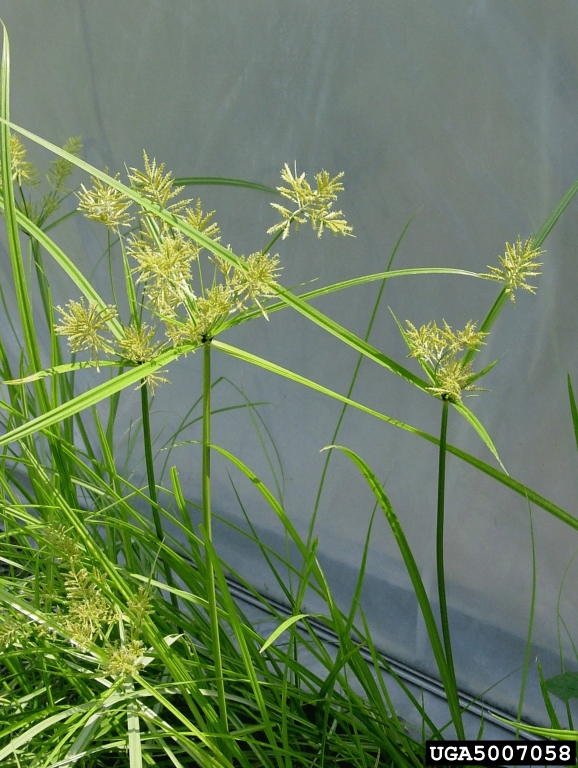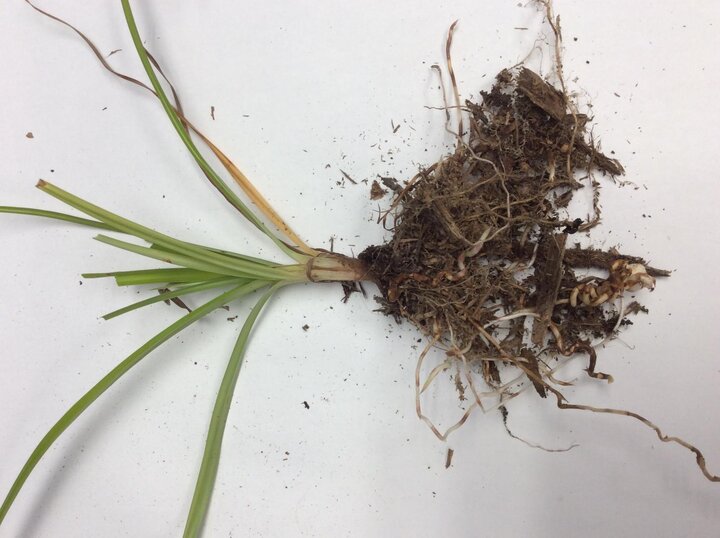Sarah Browning, Nebraska Extension Educator

Mature seedheads on yellow nutsedge. Mark Czarnota, University of Georgia, Bugwood.org
In the last week or two, have you started to see light yellowish-green grass-like plants in your lawn or landscape beds? Guess what? You may have yellow nutsedge and it's started growing for another year.

Identification
Yellow nutsedge is a member of the sedge family although it closely resembles a grass. In fact it is frequently called nutgrass or watergrass. It is a common weed in lawns and landscapes, and can often be found in areas with moist soil. Yellow nutsedge is a perennial plant, meaning the below ground portion of each plant survives the winter and generates new top growth each spring.
When you look at it closely, yellow nutsedge has a unique form and can easily be distinguished from turf grasses and other grassy weeds. The leaf blades are light green and are "V" shaped with a prominent ridge down the center of the leaf blade. Leaf arrangement on the plants is called 3-ranked, meaning the leaves originate from the base of the plant giving the lower stem a distinctive triangle shape.
The leaf blades always seem to grow faster than surrounding grass, sticking up above the turf only a few days after mowing. The root system is shallow and fibrous and produces small nut-like tubers that serve as food storage organs. Each of these small tubers can sprout and form a new plant.
Yellow nutsedge is a perennial, meaning each individual plant can live for many years if not controlled.

Control
Controlling yellow nutsedge can be difficult. Pulling them is effective if you are persistent and don't get discouraged. You will kill plants you pull, and they will not regrow. But if you pull a plant that is one year old or more, small tubers attached to its roots that have already formed in the soil will break off and remain in the soil. And each one will sprout into a new plant, making it look like the problem is getting worse rather than better. Where you initially had one plant, you may now have four - or more. Research on yellow nutsedge has shown that each individual plant can produce many tubers and tuber production begins when each newly emerged plant is only 8 weeks old.
But don't give up... these new plants can be controlled if you pull them very soon after they emerge, before they form new tubers on their roots. However, if new plants are allowed to mature and develop tubers before being pulled, then hand pulling will not give control. Persistent pulling of any new plants as soon as they appear is key.
If yellow nutsedge is growing in your lawn, anything you do to encourage a thick healthy turf will reduce the problem. Mow your lawn between 3.0 to 3.5" height throughout the year, mow as often as needed to remove no more than 1/3 leaf height each time, fertilization as needed to maintain good grass growth, and provide deep, infrequent irrigation as needed during dry periods. Aerate your lawn in spring and/or fall to reduce soil compaction. All these practices will improve turf health and thus reduce yellow nutsedge.
In areas with heavy yellow nutsedge infestation, chemical control may provide the only viable option. Common grass and broadleaf herbicides will not control yellow nutsedge. Specialized herbicides for controlling sedges must be used.
Halosulfuron, sold to homeowners in the product Sedgehammer, is one choice for nutsedge control. Sulfentrazone is a newer chemical now available to homeowners and is also very effective. Homeowners can find sulfentrazone in products like Bonide Sedge Ender or Ortho Sedge Killer. Several applications are needed to provide control no matter which product you use. Follow label directions for reapplications and any restrictions on the total number of applications that can be made in a year.
On a side note, sulfentrazone is also effective at killing annual grassy weeds like foxtail and crabgrass, so can be used for multiple purposes. But it is selective and will not damage your lawn grass if used properly, according to label directions.
When applying herbicides, avoid mowing about three days before and after treatment. To ensure adequate herbicide absorption, do not water the lawn for at least 24 hours after product application. Applications should ideally be initiated before June 21, when nutsedge is young, actively growing and is most sensitive to herbicidal control. Once this weed matures, control is difficult regardless of the treatment schedule.
Images
- Yellow nutsedge root system. Sarah Browning, Nebraska Extension.
- Close-up of tuber on yellow nutsedge root. Sarah Browning, Nebraska Extension
Search Our Archive
Associated Video
Controlling Nutsedge
UNL Plant Sciences Research Manager Matt Sousek talks about why yellow nutsedge is so hard to control and offers a few tips on management. UNL Turfgrass Program PhD student Luqi Li shows us how one nutsedge tuber can take over bare soil.